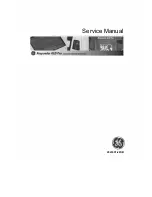
2-8 Thermo
Electron
January
2004
REMOTE
COMMUNICATIONS
CONNECTIONS
The UV6000LP has the following remote communications inputs
(Figure 2.2):
Start
This input receives an inject signal from the autosampler or manual
injector and sends a run-start signal to the PC-based software. During
installation, you must hardwire this input to your autosampler or
injector output. For Thermo Electron autosamplers, connect this input
to the autosampler’s Inject Out (pin 6) output, and the UV6000LP
COM terminal to the autosampler ground (pin 1). If the autosampler
or injector uses TTL to trigger the run, connect the TTL trigger to the
detector’s START terminal and the signal’s ground or return to the
detector’s COM terminal. If the autosampler or injector uses a relay,
connect the Normally Open output to the START terminal and the
common output to the COM terminal. (Refer to the autosampler or
injector documentation to determine whether TTL or a relay is used.)
NOTE: All of the COM terminals on the rear of the detector are tied to a
single digital ground or return line. You can use any COM terminal for any
digital input or output signal return connection.
Zero
The ZERO connection on the rear panel is used to zero the detector
from a remote source, generally at the start or end of each sample run.
It can be triggered from a remote device by either a TTL low signal or
a contact closure. If the remote instrument uses TTL to trigger the
zero, then the TTL trigger is connected to the detector’s ZERO
terminal and the ground of the triggering device is connected to the
COM terminal of the detector. If the remote instrument will be using
a relay or contact closure, then the Normally Open output is
connected to the detector’s ZERO terminal and the common output is
connected to the COM terminal.
Outputs
NOTE: Do not connect the remote outputs of the detector (RUN, READY,
and EVENT) to other equipment at this time. The senses (active high/active
low) of these outputs must match those of the connecting equipment inputs.
Wait until you power up the detector and adjust the senses as necessary with
either ChromQuest or Atlas software.
Summary of Contents for Finnigan SpectraSYSTEM UV6000LP
Page 1: ...Finnigan SpectraSYSTEM UV6000LP Detector Reference Manual A0099 595 Revision F ...
Page 8: ......
Page 12: ......
Page 16: ......
Page 44: ......
Page 76: ......
Page 91: ...January 2004 Thermo Electron 5 15 Figure 5 8 Holmium oxide absorbance spectrum ...
Page 118: ......
Page 129: ...January 2004 Thermo Electron 8 11 PD Z115E Figure 8 6 Power button and bracket removal ...
Page 134: ......
















































